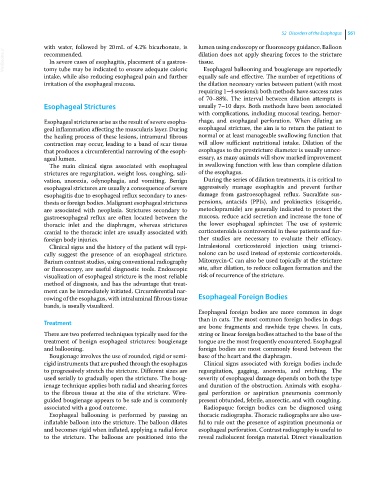Page 593 - Clinical Small Animal Internal Medicine
P. 593
52 Disorders of the Esophagus 561
with water, followed by 20 mL of 4.2% bicarbonate, is lumen using endoscopy or fluoroscopy guidance. Balloon
VetBooks.ir recommended. dilation does not apply shearing forces to the stricture
In severe cases of esophagitis, placement of a gastros-
tissue.
Esophageal ballooning and bougienage are reportedly
tomy tube may be indicated to ensure adequate caloric
intake, while also reducing esophageal pain and further equally safe and effective. The number of repetitions of
irritation of the esophageal mucosa. the dilation necessary varies between patient (with most
requiring 1–4 sessions); both methods have success rates
of 70–88%. The interval between dilation attempts is
Esophageal Strictures usually 7–10 days. Both methods have been associated
with complications, including mucosal tearing, hemor-
Esophageal strictures arise as the result of severe esopha- rhage, and esophageal perforation. When dilating an
geal inflammation affecting the muscularis layer. During esophageal stricture, the aim is to return the patient to
the healing process of these lesions, intramural fibrous normal or at least manageable swallowing function that
contraction may occur, leading to a band of scar tissue will allow sufficient nutritional intake. Dilation of the
that produces a circumferential narrowing of the esoph- esophagus to the prestricture diameter is usually unnec-
ageal lumen. essary, as many animals will show marked improvement
The main clinical signs associated with esophageal in swallowing function with less than complete dilation
strictures are regurgitation, weight loss, coughing, sali- of the esophagus.
vation, anorexia, odynophagia, and vomiting. Benign During the series of dilation treatments, it is critical to
esophageal strictures are usually a consequence of severe aggressively manage esophagitis and prevent further
esophagitis due to esophageal reflux secondary to anes- damage from gastroesophageal reflux. Sucralfate sus-
thesia or foreign bodies. Malignant esophageal strictures pensions, antacids (PPIs), and prokinetics (cisapride,
are associated with neoplasia. Strictures secondary to metoclopramide) are generally indicated to protect the
gastroesophageal reflux are often located between the mucosa, reduce acid secretion and increase the tone of
thoracic inlet and the diaphragm, whereas strictures the lower esophageal sphincter. The use of systemic
cranial to the thoracic inlet are usually associated with corticosteroids is controversial in these patients and fur-
foreign body injuries. ther studies are necessary to evaluate their efficacy.
Clinical signs and the history of the patient will typi- Intralesional corticosteroid injection using triamci-
cally suggest the presence of an esophageal stricture. nolone can be used instead of systemic corticosteroids.
Barium contrast studies, using conventional radiography Mitomycin‐C can also be used topically at the stricture
or fluoroscopy, are useful diagnostic tools. Endoscopic site, after dilation, to reduce collagen formation and the
visualization of esophageal stricture is the most reliable risk of recurrence of the stricture.
method of diagnosis, and has the advantage that treat-
ment can be immediately initiated. Circumferential nar-
rowing of the esophagus, with intraluminal fibrous tissue Esophageal Foreign Bodies
bands, is usually visualized.
Esophageal foreign bodies are more common in dogs
than in cats. The most common foreign bodies in dogs
Treatment
are bone fragments and rawhide type chews. In cats,
There are two preferred techniques typically used for the string or linear foreign bodies attached to the base of the
treatment of benign esophageal strictures: bougienage tongue are the most frequently encountered. Esophageal
and ballooning. foreign bodies are most commonly found between the
Bougienage involves the use of rounded, rigid or semi- base of the heart and the diaphragm.
rigid instruments that are pushed through the esophagus Clinical signs associated with foreign bodies include
to progressively stretch the stricture. Different sizes are regurgitation, gagging, anorexia, and retching. The
used serially to gradually open the stricture. The boug- severity of esophageal damage depends on both the type
ienage technique applies both radial and shearing forces and duration of the obstruction. Animals with esopha-
to the fibrous tissue at the site of the stricture. Wire‐ geal perforation or aspiration pneumonia commonly
guided bougienage appears to be safe and is commonly present obtunded, febrile, anorectic, and with coughing.
associated with a good outcome. Radiopaque foreign bodies can be diagnosed using
Esophageal ballooning is performed by passing an thoracic radiographs. Thoracic radiographs are also use-
inflatable balloon into the stricture. The balloon dilates ful to rule out the presence of aspiration pneumonia or
and becomes rigid when inflated, applying a radial force esophageal perforation. Contrast radiography is useful to
to the stricture. The balloons are positioned into the reveal radiolucent foreign material. Direct visualization

